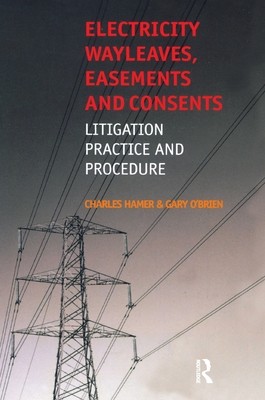
- We will send in 10–14 business days.
- Author: Charles Hamer
- Publisher: Estates Gazette
- ISBN-10: 1138146862
- ISBN-13: 9781138146860
- Format: 14.8 x 21 x 2.1 cm, kieti viršeliai
- Language: English
- SAVE -10% with code: EXTRA
Reviews
Description
'Wayleave' is an archaic term from the nineteenth century defined as 'a privilege enabling a person to cross another person's land with infrastructure and with goods and chattels'. It has been applied to electricity rights because of the need to string electricity lines across land.
Electricity is such a fundamental part of life that its supply is often taken for granted. In reality, the rights for electricity lines are arguably the weakest of all utilities, with the vast majority covered by wayleaves. Privatisation in the 1990s provided the opportunity to bolster wayleave rights, but it only led to a tinkering through primary legislation. The acceleration of telecommunications over the past twenty years has confused issues, with operators installing masts and adding apparatus to electricity lines. A large proportion of wayleaves are dealt with at local level, with little consistency. Coupled to this is the public concern that electricity lines have potentially serious health effects that continue to attract research and media interest.
This book has been written for those involved in, or advising on, the use and development of land for transmission and distribution lines. As most people have only brief encounters with the electricity infrastructure, this guide will help to avoid the fear of the unknown. By setting out the main principles and procedures used and the relevant primary and secondary legislation in a clear and easy-to-follow way it will enable lawyers, surveyors, planners, architects, engineers and accountants to discuss the relevant issues with confidence.
EXTRA 10 % discount with code: EXTRA
The promotion ends in 22d.14:45:40
The discount code is valid when purchasing from 10 €. Discounts do not stack.
- Author: Charles Hamer
- Publisher: Estates Gazette
- ISBN-10: 1138146862
- ISBN-13: 9781138146860
- Format: 14.8 x 21 x 2.1 cm, kieti viršeliai
- Language: English English
'Wayleave' is an archaic term from the nineteenth century defined as 'a privilege enabling a person to cross another person's land with infrastructure and with goods and chattels'. It has been applied to electricity rights because of the need to string electricity lines across land.
Electricity is such a fundamental part of life that its supply is often taken for granted. In reality, the rights for electricity lines are arguably the weakest of all utilities, with the vast majority covered by wayleaves. Privatisation in the 1990s provided the opportunity to bolster wayleave rights, but it only led to a tinkering through primary legislation. The acceleration of telecommunications over the past twenty years has confused issues, with operators installing masts and adding apparatus to electricity lines. A large proportion of wayleaves are dealt with at local level, with little consistency. Coupled to this is the public concern that electricity lines have potentially serious health effects that continue to attract research and media interest.
This book has been written for those involved in, or advising on, the use and development of land for transmission and distribution lines. As most people have only brief encounters with the electricity infrastructure, this guide will help to avoid the fear of the unknown. By setting out the main principles and procedures used and the relevant primary and secondary legislation in a clear and easy-to-follow way it will enable lawyers, surveyors, planners, architects, engineers and accountants to discuss the relevant issues with confidence.


Reviews